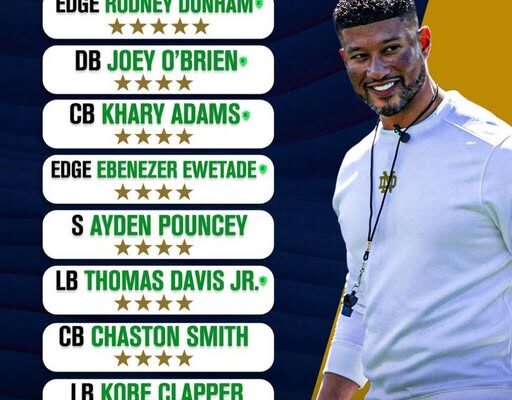The Notre Dame Football Recruiting Class: An In-Depth Look
The University of Notre Dame has long been synonymous with college football excellence. Known for its rich history, iconic stadium, and passionate fan base, Notre Dame consistently attracts top talent. Each recruiting class is critical to maintaining and building on the program’s storied tradition. This year’s recruiting class reflects both the challenges and opportunities faced by the Fighting Irish as they strive to stay competitive in a rapidly evolving college football landscape.
This analysis will explore the class comprehensively — examining the recruits’ profiles, how the class fits Notre Dame’s scheme, strengths and weaknesses, and its potential impact on the team’s future.
Recruiting at Notre Dame is unique due to several factors:
- Academic Standards: Notre Dame holds high academic standards for its recruits, which can narrow the pool of eligible players.
- Independent Status: Unlike most Power 5 programs, Notre Dame is an FBS independent in football. This impacts recruiting as the school can pitch a national schedule and exposure.
- Tradition and Prestige: Notre Dame’s history and brand appeal give it a recruiting edge despite its academic and scheduling quirks.
- Coaching Stability: With Brian Kelly stepping down and Marcus Freeman taking over, this class represents the early recruiting efforts of a new coaching regime.
- Geographic Footprint: Notre Dame recruits nationally but has traditionally drawn heavily from the Midwest and East Coast.
Given these dynamics, Notre Dame’s recruiting class must balance athletic talent, character, and academic fit while appealing to prospects who want exposure and development for NFL potential.
Notre Dame’s 2025 recruiting class, as evaluated by major recruiting services, ranks solidly within the top 15 nationally. The class features a mix of high-profile four-star athletes, several five-star talents, and promising developmental prospects. The class composition reflects the coaching staff’s priorities in key position groups, especially on defense and skill positions on offense.
The coaching staff has emphasized versatility, character, and scheme fit. The trend is toward multi-dimensional athletes who can play multiple positions or adapt to various defensive or offensive looks. There is also an emphasis on speed and athleticism, aligning with modern football’s demand for quickness and explosiveness.
- Quarterbacks: Secured a key quarterback prospect with strong arm talent and mobility. Notre Dame continues its search for a franchise signal-caller, focusing on a player who fits the dual-threat mold.
- Running Backs: Targeted a mix of power runners and explosive backs who can contribute in the passing game.
- Wide Receivers: Loaded with speedsters and route-runners, the class aims to bolster a receiving corps that has been inconsistent.
- Offensive Line: Focused on size and technical skills, recruiting several offensive linemen with high upside to protect the quarterback and open running lanes.
- Defensive Line: Prioritized disruptive defensive linemen who can penetrate gaps and apply pressure.
- Linebackers: Emphasized athletic linebackers who can cover tight ends and backs while also stopping the run.
- Defensive Backs: Added several versatile defensive backs capable of playing both cornerback and safety roles.
A four-star recruit from Texas, Harrison stands out for his arm strength, poise under pressure, and athleticism. His ability to extend plays and throw accurately on the move makes him an ideal fit for Notre Dame’s evolving offense. While still raw in some aspects, his ceiling is high, and he has drawn comparisons to past Notre Dame dual-threat quarterbacks.
Carter is a five-star defensive end from Georgia, known for his explosiveness off the edge and relentless motor. His quickness and ability to collapse the pocket will add a needed dynamic presence to the defensive line. He’s expected to compete for immediate playing time given his physical readiness
A speedy four-star receiver from California, Fields brings excellent route-running and hands. He’s a threat in the slot and on the perimeter, able to stretch defenses vertically and create separation. Notre Dame’s offense could leverage his skills in the passing game to open up play-action opportunities
O’Connor is a five-star offensive tackle from Ohio, known for his elite size, footwork, and strength. Projected as a future cornerstone of the offensive line, he provides Notre Dame with a potential franchise left tackle who can protect the quarterback’s blind side and anchor the run game.
An athletic linebacker from Florida, Daniels combines size and speed, making him a perfect fit for Notre Dame’s defensive schemes. His coverage ability will be critical against tight ends and running backs, while his tackling skills will shore up run defense.
Notre Dame’s recruiting staff has placed a premium on speed across all position groups. From defensive backs who can match up with fast receivers to wide receivers who can stretch the field, the class is designed to play an up-tempo, dynamic style.
Many recruits can play multiple positions. This versatility allows the coaching staff to create matchup advantages and adjust personnel packages dynamically, a crucial factor in today’s game.
The defensive recruits, particularly along the line and linebacker corps, stand out for their potential to improve a defense that struggled in key moments last season. The mix of power, quickness, and football IQ in this class is a significant plus.
Notre Dame emphasizes recruiting players who fit the program’s culture of integrity and leadership. Early reports suggest this class includes several high-character individuals who will be good teammates and representatives of the university
Although the class has a promising quarterback, the depth behind him is somewhat thin. This could pose a risk if injuries occur or if the top recruit requires time to develop.
While there are some players ready to contribute right away, much of the class is developmental, which means Notre Dame may not see significant improvements in all position groups immediately.
The offensive line recruits are talented but lack extensive game experience at the college level. The line will likely need time to gel and develop cohesion before reaching peak performance.
Certain spots, such as running back and safety, may lack sufficient depth in the class to provide immediate competition or injury insuranc
Notre Dame’s offense under the new regime is expected to be a more balanced, multi-faceted attack with an emphasis on tempo and versatility. The quarterback recruited fits a spread, dual-threat mold, and the skill position players bring speed and route-running precision that complement this style. The offensive line recruits are expected to develop into a solid front that supports both the run and pass.
Defensively, Notre Dame aims to be aggressive, attacking opponents with speed and physicality. The defensive linemen and linebackers recruited are well-suited to a scheme that values pressure and versatility. The secondary recruits’ ability to play multiple roles will allow the defense to disguise coverages and adapt to different offensive formations.
Compared to recent recruiting classes, this one stands out for its balance of high-end talent and positional need. Notre Dame has had classes with more five-star recruits, but this group offers a solid foundation for the future, especially under new leadership. It may not be the flashiest class, but its strengths align well with the program’s immediate and long-term goals
In the short term, the class may not dramatically alter the team’s fortunes. Some of the recruits, particularly in skill positions and defensive line, could see playing time early, but the team will rely heavily on upperclassmen.
Long-term, this class is poised to shape Notre Dame’s core. Players like Ethan Harrison, Jalen Carter, and Liam O’Connor could become program leaders and future NFL prospects. If development goes according to plan, this recruiting class could help Notre Dame return to national title contention within the next few seasons.
Notre Dame’s coaching staff faces challenges in player development, depth chart management, and maintaining academic and cultural standards. Integrating this class into the existing roster while competing against elite programs will require excellent coaching and player commitment.
Additionally, the changing landscape of college football — including NIL (Name, Image, Likeness) dynamics and transfer portal activity — complicates roster building. Notre Dame’s ability to retain recruits and supplement this class with transfers will be critical.
Notre Dame’s 2025 recruiting class represents a thoughtful and strategic approach to rebuilding and sustaining one of college football’s most prestigious programs. While not without weaknesses, the class offers a strong mix of athleticism, versatility, and character. The key recruits at quarterback, defensive end, wide receiver, and offensive line could form the nucleus of a competitive Fighting Irish squad in the years to come.
As the new coaching staff begins to imprint its identity, this recruiting class will be a vital component in shaping Notre Dame’s path forward. If development and retention go well, Notre Dame fans have much to be optimistic about.



